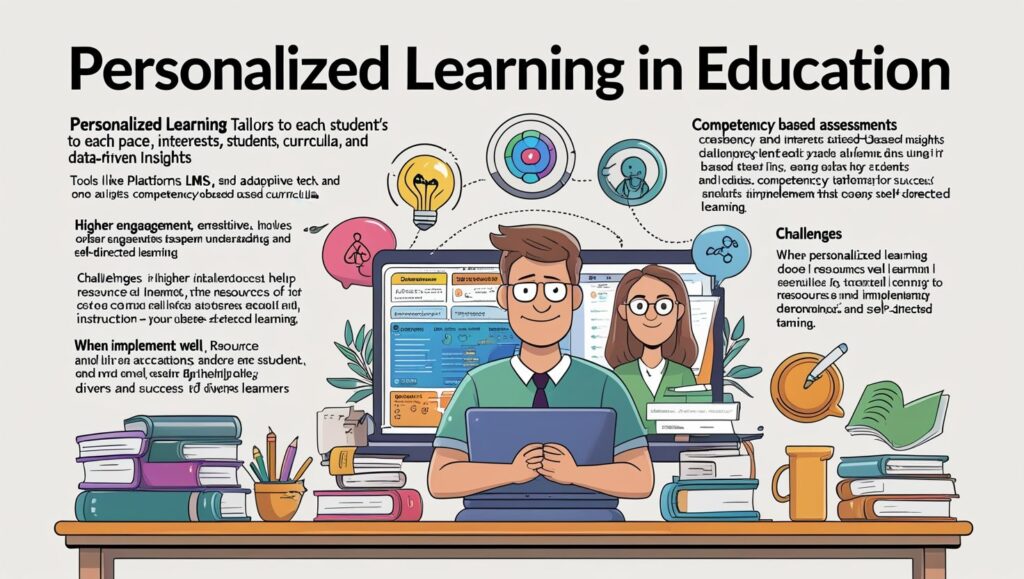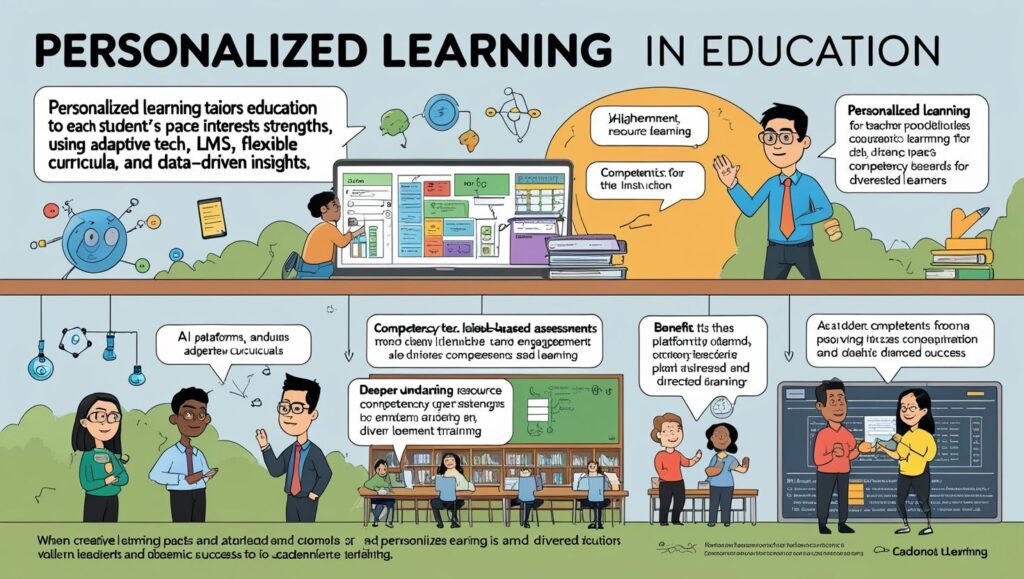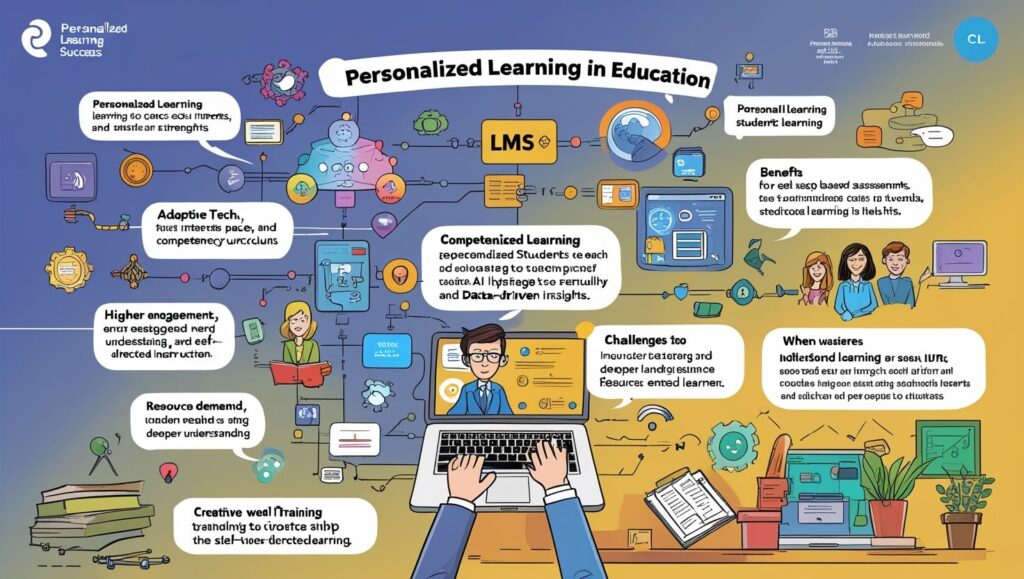Introduction
Personalized Learning in Education, Personalized learning has emerged as a transformative approach in modern education. It shifts the focus from traditional, one-size-fits-all instruction to tailored learning experiences. Significantly, this method adapts to each student’s strengths, needs, and interests. As a result, learners feel more engaged and motivated. In today’s diverse classrooms, personalized learning is more relevant than ever.
Moreover, personalized learning aligns well with technology-driven education. With digital tools, educators can design individual paths for students. Consequently, students can progress at their own pace. This freedom helps in developing self-regulation and critical thinking. Besides, it creates a stronger connection between learners and the content.
Notably, personalized learning encourages student agency. Learners make choices in their learning process. For instance, they can select topics, pace, or learning styles. Hence, learning becomes meaningful and enjoyable. Furthermore, educators can gather real-time data to make timely interventions.
Equally important is the role of teachers. Although technology supports personalization, teachers guide and support learners. Therefore, successful implementation requires teacher training and curriculum adjustments. With proper support, personalized learning enhances achievement for all students. Thus, it holds great promise for the future of education.
Historical Background and Evolution
Initially, education systems were designed for uniformity. Standardized curricula and rigid teaching styles dominated classrooms. Consequently, individual learning differences were overlooked. Over time, however, educators recognized the limitations of this model. As a result, alternative approaches began to emerge.
In the 20th century, educational theorists like John Dewey emphasized child-centered learning. He argued for instruction that responds to student needs. Simultaneously, psychologist Lev Vygotsky introduced the idea of the “zone of proximal development.” This concept highlighted the importance of individual learning paths. Therefore, a shift toward personalization slowly began.
With the advent of computers in education during the 1980s, personalized instruction gained momentum. Initially, software provided practice drills. Gradually, adaptive technologies were developed. These allowed real-time customization of learning content. Hence, personalization became more practical and scalable.
More recently, learning management systems and AI tools have expanded possibilities. Teachers can now analyze student data and adjust instruction instantly. Additionally, online platforms provide students with voice and choice. As a result, modern classrooms are evolving rapidly.
Although still developing, personalized learning is gaining recognition worldwide. Countries are experimenting with flexible models. With growing research and technological advances, this approach continues to redefine education. Thus, personalized learning is both a product of history and a vision for the future.

Core Principles of Personalized Learning
Personalized learning rests on several foundational principles. First and foremost is learner agency. This means students take ownership of their education. They set goals, monitor progress, and reflect on outcomes. Consequently, they develop responsibility and self-direction.
Another principle is flexible learning paths. Not all students learn the same way or at the same pace. Therefore, personalized learning offers varied methods and materials. For instance, visual learners can use videos, while kinesthetic learners prefer hands-on tasks. As a result, each student receives what works best for them.
Equally important is real-time assessment. Unlike traditional testing, personalized learning uses ongoing feedback. Teachers assess students continuously and adapt lessons accordingly. Hence, learning becomes dynamic and responsive. Moreover, students receive support exactly when needed.
Furthermore, meaningful content is vital. Personalized learning connects academic work to student interests. This relevance boosts engagement. When students relate to the material, they retain more information. Consequently, their learning outcomes improve significantly.
Collaboration also plays a key role. Although learning is individualized, students still interact with peers. Group projects, discussions, and peer reviews foster social skills. Additionally, technology assists in connecting learners across distances. Together, these principles create a robust framework for personalized learning.
Role of Technology in Personalization
Technology plays a central role in personalized learning. It enables educators to deliver customized instruction efficiently. For instance, learning platforms like Khan Academy and Google Classroom offer adaptive lessons. As students progress, the software adjusts content. Consequently, each learner receives a unique experience.
Moreover, artificial intelligence is enhancing personalization. AI tools analyze student data to identify strengths and weaknesses. Based on this, they suggest appropriate resources. Thus, students get immediate support. Teachers also benefit. With dashboards, they can track progress in real time. Hence, interventions become timely and effective.
In addition, technology expands access. Students can learn anytime and anywhere. With mobile apps and cloud-based tools, learning is no longer confined to classrooms. This flexibility benefits diverse learners, especially those with other needs or scheduling conflicts.
Furthermore, virtual reality (VR) and augmented reality (AR) add immersive experiences. These tools make complex topics easier to understand. For example, students can explore the human body in 3D. Therefore, learning becomes engaging and interactive.
Despite these advantages, challenges exist. Not all students have equal access to devices or the internet. Also, teachers need training to use technology effectively. However, with proper support, technology can significantly enrich personalized learning. Thus, it is a powerful enabler of educational transformation.
Benefits of Personalized Learning
Personalized learning offers numerous advantages. Firstly, it boosts student engagement. Since lessons align with interests and needs, students are more involved. This leads to deeper understanding and higher motivation. Consequently, learners enjoy the process more.
Secondly, it improves academic outcomes. Because content is tailored, students grasp concepts better. They can revisit topics until they master them. As a result, performance improves across subjects. Also, struggling students receive targeted support, which helps bridge learning gaps.
Moreover, personalized learning promotes independence. Learners take charge of their progress. They set goals and reflect on results. Hence, they develop critical life skills like time management and decision-making. These competencies are essential beyond school.
Equally important is inclusivity. Personalized approaches accommodate diverse learners. Students with disabilities, language barriers, or different learning styles benefit significantly. By addressing individual needs, education becomes equitable. Thus, every learner gets a fair chance to succeed.
Additionally, teacher-student relationships improve. With data and insights, teachers understand students better. They can offer emotional and academic support. This creates a positive classroom environment.
While there are implementation hurdles, the benefits are substantial. Personalized learning enhances not only academic results but also lifelong skills. Therefore, it is a valuable model for modern education systems.

Challenges and Limitations
Despite its promise, personalized learning faces several challenges. First, access to technology remains unequal. In many regions, students lack devices or internet connectivity. Consequently, digital personalization becomes difficult. Without adequate infrastructure, gaps widen instead of narrowing.
Additionally, teachers often feel unprepared. Implementing personalized learning requires new skills. Teachers must analyze data, use software, and design flexible lessons. Therefore, professional development is essential. However, many schools lack resources for ongoing training.
Time constraints also hinder progress. Creating individualized plans for many students is demanding. Teachers need support and planning time. Without it, they may revert to traditional methods.
Moreover, data privacy raises concerns. Personalized learning relies heavily on student data. While this supports customization, it also risks security breaches. Schools must protect sensitive information. Therefore, strict policies and tools are necessary.
Another challenge is curriculum alignment. Standardized tests and rigid curricula conflict with personalized approaches. Teachers must balance flexibility with required content. This balancing act can be stressful and complex.
Student motivation can also vary. Not all learners are ready for self-directed tasks. Some need structure and guidance. Consequently, educators must scaffold the transition to independence.
In short, personalized learning is not a magic solution. It demands investment, planning, and care. Addressing these limitations is vital for its success.
Teacher’s Role in Personalized Learning
Teachers are central to successful personalized learning. They guide, support, and inspire learners. Even with technology, human interaction remains critical. Teachers understand emotional cues, context, and motivation better than machines. Hence, their involvement is irreplaceable.
First, teachers design individualized learning plans. They assess student interests, strengths, and needs. Based on this, they select activities and resources. Although software helps, teacher judgment ensures relevance and appropriateness.
Moreover, teachers monitor progress closely. They use formative assessments to adjust instruction. For example, if a student struggles with fractions, the teacher may provide additional exercises or real-world examples. As a result, learning becomes effective and timely.
Furthermore, teachers foster student agency. They encourage goal-setting and reflection. By doing so, students learn to own their progress. This builds confidence and lifelong learning habits.
Equally important is building relationships. Teachers create a safe and supportive environment. They celebrate successes and offer encouragement. These connections increase student engagement.
Teachers also collaborate with families. Sharing learning goals and strategies strengthens the support system. Moreover, teachers learn from students too. Listening to their preferences enhances planning.
In conclusion, teachers are facilitators in personalized learning. Their role is evolving but remains essential. With adequate support, they can drive meaningful, student-centered education.
Personalized Learning in Different Education Levels
Personalized learning varies across educational stages. In early childhood, it focuses on developmental needs. Young children explore through play and guided activities. Teachers observe and adapt accordingly. Hence, personalization supports foundational skills and curiosity.
At the primary level, the approach becomes more structured. Students begin formal learning in literacy and numeracy. Personalized strategies may include reading groups, math centers, and differentiated tasks. Therefore, students receive content that matches their abilities.
In secondary education, personalization grows more complex. Students have diverse interests and academic paths. They may choose electives, set goals, and work on independent projects. Teachers provide flexible assessments and real-time feedback. As a result, students take greater responsibility.
For higher education, personalized learning often involves online platforms. University students use digital tools for lectures, assignments, and discussions. Self-paced modules and adaptive quizzes are common. Consequently, learners manage their education based on schedules and career goals.
In vocational and adult education, personalization aligns with job skills. Learners select programs based on goals. Courses offer simulations, practical tasks, and personalized mentorship. This relevance improves retention and performance.
Each stage requires tailored strategies. Although the methods differ, the goal remains the same: to meet learners where they are. Therefore, personalized learning is adaptable and effective at all levels.

Global Examples and Success Stories
Personalized learning is gaining traction worldwide. Several countries have implemented successful models. In the United States, Summit Public Schools use a personalized platform. Students set weekly goals and track their progress. Teachers mentor them regularly. As a result, students show improved engagement and academic growth.
In Finland, education is highly student-centered. Teachers create individual learning plans in collaboration with students and parents. Moreover, flexible timetables and interdisciplinary projects enhance personalization. Consequently, Finnish students consistently perform well on global assessments.
India is also exploring personalized models. Startups like BYJU’S offer adaptive learning platforms. These tools analyze student performance and adjust content accordingly. In rural areas, such technology bridges learning gaps.
In Kenya, the Tusome project uses digital tools to personalize reading instruction. Teachers use tablets to monitor student progress. This initiative has significantly improved literacy rates. Hence, it is a model for scalable impact.
Australia’s New South Wales education system supports personalized learning through project-based work. Students choose real-world problems to solve. This method fosters engagement and critical thinking.
These examples prove that personalized learning is not confined to wealthy nations. With innovation and commitment, any system can implement it. Thus, global success stories offer inspiration and practical insights for educators everywhere.
Conclusion and Future Prospects
Personalized learning is redefining the educational landscape. It responds to the unique needs of every learner. By focusing on strengths, interests, and goals, it promotes deeper understanding and motivation. Moreover, it equips students with vital life skills.
Despite challenges, the approach holds immense promise. Technology, when used wisely, can bridge gaps and enhance personalization. Equally, teacher support, training, and policy reforms are crucial for success. Investment in infrastructure and inclusive practices will make personalized learning accessible to all.
Looking ahead, artificial intelligence and data analytics will further refine personalization. New models may include predictive tools and real-time feedback loops. Additionally, student voice will grow stronger in curriculum planning. As a result, learning will become even more engaging.
However, equity must remain a priority. Policymakers and educators should ensure that no learner is left behind. By addressing barriers and providing resources, personalized learning can become a universal solution.
In conclusion, personalized learning is more than a trend. It is a paradigm shift toward student-centered education. With commitment and innovation, it can transform schools into thriving learning communities. Therefore, the future of education lies in personalization.
References
- Pane, J. F., Steiner, E. D., Baird, M. D., Hamilton, L. S., & Pane, J. D. (2015). Continued Progress: Promising Evidence on Personalized Learning. RAND Corporation.
- Bray, B., & McClaskey, K. (2015). Make Learning Personal: The What, Who, WOW, Where, and Why. Corwin Press.
- Walkington, C. (2013). Using adaptive learning technologies to personalize instruction. Journal of Educational Psychology, 105(4), 932–945.
- OECD (2018). The Future of Education and Skills: Education 2030. OECD Publishing.

I’ve read similar posts, but yours stood out for its clarity.
Your breakdown of the topic is so well thought out.
I always look forward to your posts. Keep it coming!
This was a very informative post. I appreciate the time you took to write it.
What I really liked is how easy this was to follow. Even for someone who’s not super tech-savvy, it made perfect sense.
This topic really needed to be talked about. Thank you.
I like how you kept it informative without being too technical.
qo4g23
yk5k6m
Glad to be one of many visitors on this awful internet site : D.
I think this is one of thhe so much significant information for me.
And i am satisfied reading youur article. However should remark on some common things,
The site style is ideal, the articles is in reality nice :
D. Good task, cheers
Here is my web page :: ดอกไม้งานศพ
hi!,I like your writing so so much! share we communicate ore about yourr post on AOL?
I require aan expert in this space to resolve mmy problem.
Maybe that’s you! Taking a look ahead to look you.
Visit my web blog; ออกแบบโลโก้ ฮวงจุ้ย ฟรี
I’m a huge fan of good glass of wine. From a lokcal vineyard or imported, it just elevates any occasion. Anyne else here love wine?
#WineTasting
Feel free to visit my webpage … ขายไวน์ราคาส่ง
Every weekend i used to pay a quihk visit this site, for
thee reason that i wish for enjoyment, as this this site conations genuinely nice funny inforation too.
My web page; นามบัตรฮวงจุ้ย
I think other site proprietors should take this web site as an model, very clean and wonderful user genial style and design, as well as the content. You are an expert in this topic!
You’re soo interesting! I don’t believe I
have read a single thing like that before.So great
to find someone with original thoughts on this topic. Really..
thanks for starting this up. This web site is something that is required on the web, someone with a little originality!
Look at my webpage … รับออกแบบโลโก้ ตามหลักฮวงจุ้ย
I really enjoy good glass oof wine. Doesn’t matter if it’s dry or sweet, wine always makes the moment better.
Anyone else here love wine? #WineTasting
Also visit my web-site: แชมเปญ
ชอบแนวคิดที่แชร์ไว้ในบทความนี้ครับ ถ้าใครกำลังมองหาบริการจัดดอกไม้งานศพ ผมแนะนำลองดูร้านที่มีผลงานจริงและรีวิวดี ๆ ครับ
Also visit my web-site ร้านพวงหรีด บางนา
บทความนี้ให้ข้อมูลมีประโยชน์มากครับ ถ้าใครกำลังมองหาผู้ให้บริการตกแต่งงานศพ ผมแนะนำลองดูร้านที่มีผลงานจริงและรีวิวดี ๆ ครับ
Feel free to visit my blog post – Aorest
I really enjoy good vintage wine. Doesn’tmatter if it’sdryor sweet,
wine always makes the moment better. Whoo else enhjoys wine tasting?
Also visit my web site; ไวน์
I really enjoy good wine. From a locsl vineyard or imported, it’s the perfect way to relax.
Are there any wine lovers around? #WineTasting
Feel free to visit mmy page – ขาย wine
I really enjoy good wine. Doesn’t matter if it’s dry or
sweet, wine always makes the moment better. Who else enjoys wine tasting?
My web page :: ร้าน ขาย ไวน์
บทความนี้ให้ข้อมูลมีประโยชน์มากครับ ถ้าใครกำลังมองหาผู้ให้บริการตกแต่งงานศพ ผมแนะนำลองดูร้านที่มีผลงานจริงและรีวิวดี ๆ ครับ
Have a look at my blog; Ali
บทความนี้ให้ข้อมูลมีประโยชน์มากครับ ถ้าใครกำลังมองหาบริการจัดดอกไม้งานศพ
ผมแนะนำลองดูร้านที่มีผลงานจริงและรีวิวดี ๆ ครับ
Here is my page … พวงหรีด
Can’t get enough of good glass of wine. Whether it’s redd or
white, it just elevates any occasion. Are there any wine lovers
around? #WhiteWine
my website … แชมเปญ
บทความนี้ให้ข้อมูลมีประโยชน์มากครับ ถ้าใครกำลังมองหาร้านจัดดอกไม้งานศพ ผมแนะนำลองดูร้านที่มีผลงานจริงและรีวิวดี
ๆ ครับ
My homepage – สั่งพวงหรีดผ้าขาวม้า
I rreally enjoy good vintage wine. Whether it’s red or white,
wine always makes the moment better. Who else enjys wine tasting?
#WhiteWine
Here is my blog: ร้าน ขาย ไวน์
I really enjoy good vintage wine. Frrom a loocal vineyard or imported, it’s the perfect way to relax.
Are there any wine lovers around?
Check out my web page :: แชมเปญ
Can’t get enouugh oof good vintage wine. Fromm a local vieyard or imported,
it’s the perfect way to relax. Are there any wine lovers
around?
Review my page: ไวน์ราคาถูก
Hi there just wanted to give you a brief heads up and let you know a few of the pictures aren’t loading properly. I’m not sure why but I think its a linking issue. I’ve tried it in two different web browsers and both show the same results.
Fantastic web site. Lots of useful info here. I am sending it to a few friends ans also sharing in delicious. And of course, thanks for your sweat!
Well I really enjoyed reading it. This subject provided by you is very constructive for good planning.